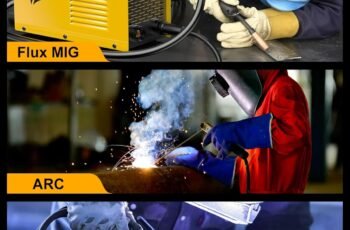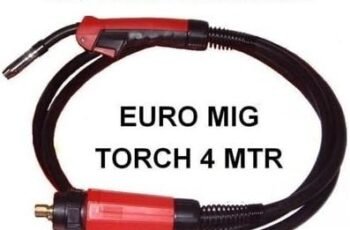Ad Blocker Detected
Our website is made possible by displaying online advertisements to our visitors. Please consider supporting us by disabling your ad blocker.
Optimizing your MIG welding machine for different materials is crucial for achieving high-quality welds. Start by selecting the right gas mix; for instance, use a 75/25 argon/CO₂ blend for mild steel and pure argon when working with aluminum. You’ll need to adjust amperage based on material thickness and balance voltage with wire feed speed. There’s more to explore, such as setting the proper polarity and troubleshooting common issues. Curious how to get that perfect “sizzling bacon” sound?
Understanding Polarity and Gas Settings
When it comes to optimizing MIG welding, understanding polarity and gas settings is crucial. You’ll want to use DCEP for most applications. This setup provides better penetration and reduces spatter, essential for clean welds on steel and stainless steel. Polarity directly affects the welding process and results, making it fundamental to understand for effective welding outcomes. For your machine, ensure the positive DINSE plug is connected correctly for DCEP.
Gas selection is equally important. For mild steel, opt for an argon/CO₂ mix, like 75/25, to stabilize the arc and minimize porosity. Aluminum requires pure argon to avoid contamination, while stainless steel benefits from argon-O₂ blends to reduce porosity.
Always maintain a gas flow rate around 15-25 CFH, adjusting for joint thickness. By fine-tuning these settings, you’ll achieve efficient, high-quality welds.
Material Thickness and Amperage Guidelines
Having a solid grasp of polarity and gas settings, you can now focus on the relationship between material thickness and amperage to optimize MIG welding.
Use the thickness-to-ampere formula by multiplying the material’s thickness in inches by 1,000 to calculate the current. For example, 0.125 inches requires 125 amps.
Stick to general guidelines like using 250 amps for 1/4″ steel, adjusting for the metal type. Consult reference charts to match thickness, wire size, and amps precisely. It’s important to consider factors affecting welding parameters, such as hand speed, material contamination, and gas quality, as they can influence the quality of the weld.
For thin metals, reduce amperage and increase travel speed to avoid burn-through. Conversely, thicker materials need higher amperage, like 180–210 amps for 6.0 mm steel, ensuring full penetration.
Match wire diameter to the appropriate amp range for optimal performance.
Balancing Voltage and Wire Feed Speed
To achieve optimal MIG welding performance, it’s crucial to balance voltage and wire feed speed effectively. Start by listening for that “sizzling bacon” sound, signaling a perfect arc. If you hear popping, your wire speed might be too high for your voltage. Hissing suggests the opposite problem. Visually, tall, narrow beads mean you should increase wire speed or lower voltage; flat, wide beads require the opposite. Remember, voltage controls bead geometry and arc stiffness, while wire speed affects metal deposition and amperage. For steel, aim for moderate voltage and balanced speed. Aluminum needs higher voltage and faster speed due to its conductivity. According to MIG Welding Wire Speed and Voltage Charts, different settings are required for flux-core and solid wire types, so always check for compatibility. Make small adjustments—0.5V or 5-10 IPM—to fine-tune settings and achieve stable arcs.
Calculating Wire Feed Speed for Different Wires
After mastering the balance of voltage and wire feed speed, it’s important to understand how wire diameter impacts feed rate calculations. Different diameters need specific multipliers: 0.045″ uses 1, 0.035″ uses 1.6, 0.030″ uses 2, and 0.023/0.024″ uses 3.5. Larger wires generally feed slower at the same amperage, while thinner wires need higher speeds for adequate melting. For instance, a 0.030″ wire feeds faster than 0.045″ on the same steel thickness. The wire feed speed is crucial in welding processes as it controls the rate at which the wire electrode is fed into the weld pool. Use the formula: Feed Speed (ipm) = Thickness (inches × 1000) × Wire Factor for accuracy. For a 1/4″ steel with 0.030″ wire, calculate 250 × 2 = 500 ipm. Keep wires clean and lubricated to avoid slippage, and use the six-second method to verify speeds.
Adjustments for Specific Materials
When you’re welding different materials, understanding the nuances of each is crucial for optimal results. For mild steel, use an ER70S-3 or ER70S-6 wire with a 75/25 Argon/CO₂ blend to improve penetration while minimizing spatter. Stainless steel benefits from an ER308L wire and a 98% Argon + 2% CO₂ gas mix to reduce oxidation. For aluminum, choose ER4043 for 6000-series or ER5356 for 5000-series, using 100% Argon or a Tri-Mix. Nickel alloys require specialty wires like ERNi-Cu for high temperatures. When dealing with variable metal thicknesses, it’s essential to match wire diameter accordingly—opt for smaller diameters for thin materials and consider using .045″ for thicker stock. Adjust amperage to 1 amp per 0.001″ thickness, and modify voltage based on material and desired transfer mode for maximum efficiency.
Troubleshooting Common Arc Issues
While welding, encountering arc issues can disrupt your workflow and affect weld quality. Start by checking your gas supply; ensure the cylinder valve’s open and the flow is adequate. Confirm your polarity’s set to DCEP for stable arc initiation.
Inspect all electrical connections to ensure good continuity between the gun, welding machine, and workpiece. Test for gas leaks around hoses, nozzles, and worn O-rings, as leaks can compromise shielding. Ensure your contact tip’s clean and functioning properly.
If wire feed malfunctions arise, adjust drive roll pressure to avoid slipping. Increase wire feed speed to tackle burn-backs. Clean any clogged contact tubes and trim MIG gun liners to the correct length.
Finally, align power pins in the drive casting properly to maintain good connections.
Best Practices for Optimization
To achieve optimal MIG welding results, it’s crucial to tailor your machine settings to the specifics of your task.
Begin by setting the voltage and wire speed according to the material’s thickness—use 1 A per 0.001” of thickness. Choose the right wire diameter to match the required intensity and adjust the voltage to control weld height and width. Check machine specifications for proper polarity settings.
Always conduct test runs to validate quality before large-scale production. Conduct multiple tests to balance quality and speed, and document successful parameters for future use.
Leverage Auto-Set technology for quick adjustments, especially for beginners. Optimize gas flow to prevent porosity and use a stickout of 1/4″-1/2″.
Implement MIG pulsing for thermal control on thin materials.
Conclusion
To optimize your MIG welding settings, always start by setting the right polarity and gas mix for the material. Calculate the amperage based on thickness and adjust the voltage and wire feed until you hear that “sizzling bacon” sound. Regularly check for gas leaks and clean your wire to ensure smooth operation. By fine-tuning these elements, you’ll achieve better weld quality and efficiency on various materials. Keep practicing and troubleshooting to perfect your technique.



